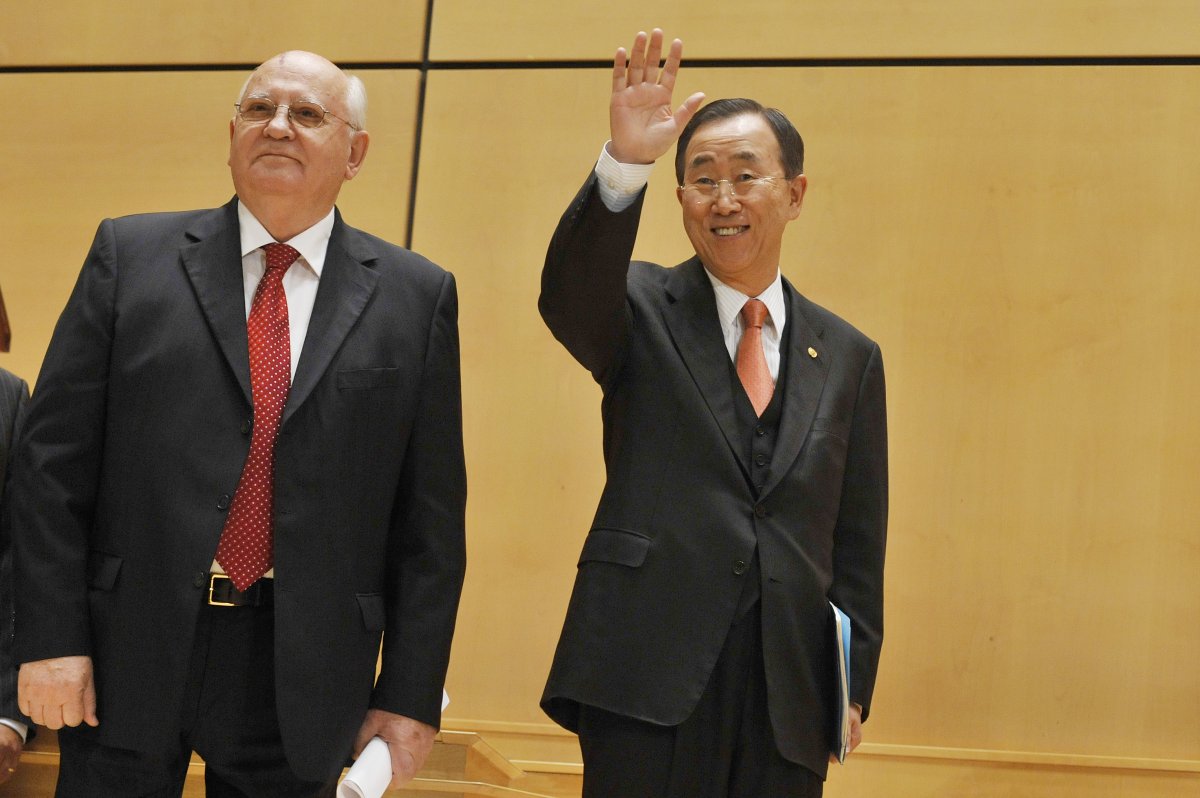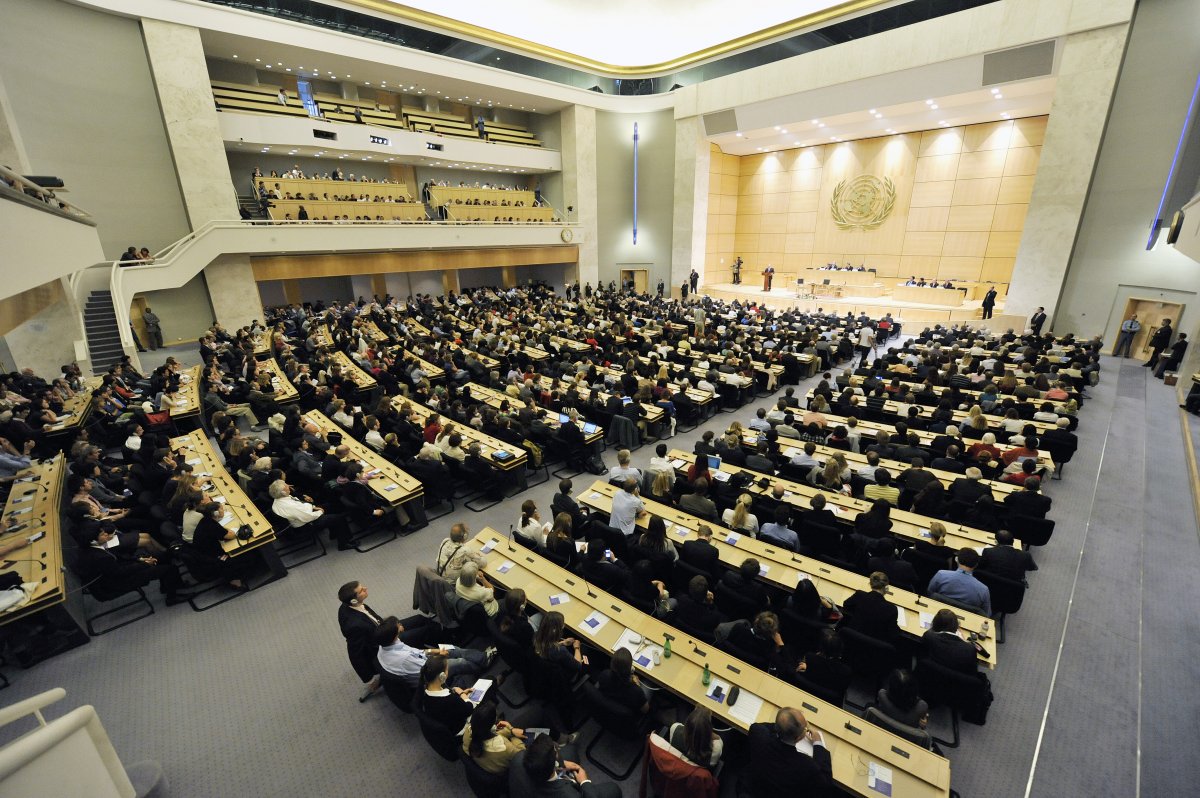
Former President Gorbachev and Secretary-General Ban Ki-moon call for more political will and enhanced multilateral disarmament cooperation under the UN leadership.
Speaking at the 3rd edition of the
Geneva Lecture Series, at the Palais des Nations, on 5 October, Mr. Mikhail Gorbachev called for resetting the nuclear disarmament agenda and moving toward a nuclear weapon free world. Mr. Gorbachev explained that it took him and President Reagan to “look beyond the horizon” to make a breakthrough in the nuclear disarmament process at the time of the Cold War confrontation. Indeed, political mobilization is not less needed for a successful disarmament process today. Having referred to Mr. Gorbachev “as a giant in the global effort to achieve a nuclear-weapon-free world”, Mr. Ban Ki-moon, present on this occasion, pointed out that the political will was one of the five main challenges to be met in an effort to achieve the goal of the complete elimination of nuclear weapons.
According to Mr. Gorbachev, the opportunity presented by the end of the Cold War and the fall of the Berlin Wall has been missed, and the dream of creating a new security structure was abandoned. The process of nuclear disarmament has stalled for many years. As a result, thousands of nuclear warheads still exist, verification mechanisms have deteriorated, and the
Comprehensive Test Ban Treaty (CTBT) has not been ratified. The nuclear arsenals of the two major nuclear powers exceeding the total of the others make it impossible to command broad support and engage other nuclear powers into the disarmament process. Mr. Gorbachev warned that there was “a real threat of a new nuclear arms race” and defined the non-implementation of the obligations under article 6 of the
Nuclear Non Proliferation Treaty (NPT) by the parties to the treaty, in other words the elimination of nuclear weapons, as the main root cause of the nuclear proliferation.
Having acknowledged the importance of bilateral steps, most notably by the US and Russia this year as well as the commitment of the US to sign the CTBT, the guest speaker of the 3rd Edition of the Geneva Lecture Series stressed the importance of broader measures such as the freeze of nuclear weapons by the nuclear powers, and the enhanced employment of multilateral approaches under the UN leadership. All this would allow to engage the so-called second tier nuclear powers in the disarmament process, and to break the old style mentality having as a reference point Cold War era nuclear doctrines and concepts. Mr. Gorbachev is certain that further on the way toward a nuclear-weapon-free world, the role of multilateral efforts will be growing and the UN will be “an indispensable forum for harmonizing the efforts of big and small States”. “As the only universal organization, the UN should play a more important role in the disarmament issues”, he said.

Responding to a question from the public, Mr. Gorbachev reiterated the conviction that “it was a great illusion that the nuclear weapons have helped to maintain the security in the world”. The destructive power of nuclear weapons combined with the possibilities of a mistake or an accidental launch, requires their complete elimination.
In his turn, even though having recognized the role played by President Obama in bringing the goal of a world without nuclear weapon “back where it belongs: on the top of the global agenda”, Mr. Ban Ki-moon urged further commitments by the United States such as the ratification of the CTBT. He noticed that the exercise of political will by other world leaders will be crucial in making the upcoming NPT review conference a success and “Bridging the gap between words and deeds”.
The Geneva Lecture Series is a joint initiative of UNITAR and the United Nations Office at Geneva that promotes a vibrant public debate on the complex challenges that the international community is facing.
To view background information on nuclear disarmament issues, click
here and
here
To view the press coverage for this event, click
here
To watch the video archive of the Lecture, click
here
To view the photo gallery of the Lecture, click
here


 Responding to a question from the public, Mr. Gorbachev reiterated the conviction that “it was a great illusion that the nuclear weapons have helped to maintain the security in the world”. The destructive power of nuclear weapons combined with the possibilities of a mistake or an accidental launch, requires their complete elimination.
In his turn, even though having recognized the role played by President Obama in bringing the goal of a world without nuclear weapon “back where it belongs: on the top of the global agenda”, Mr. Ban Ki-moon urged further commitments by the United States such as the ratification of the CTBT. He noticed that the exercise of political will by other world leaders will be crucial in making the upcoming NPT review conference a success and “Bridging the gap between words and deeds”.
The Geneva Lecture Series is a joint initiative of UNITAR and the United Nations Office at Geneva that promotes a vibrant public debate on the complex challenges that the international community is facing.
To view background information on nuclear disarmament issues, click here and here
To view the press coverage for this event, click here
To watch the video archive of the Lecture, click here
To view the photo gallery of the Lecture, click here
Responding to a question from the public, Mr. Gorbachev reiterated the conviction that “it was a great illusion that the nuclear weapons have helped to maintain the security in the world”. The destructive power of nuclear weapons combined with the possibilities of a mistake or an accidental launch, requires their complete elimination.
In his turn, even though having recognized the role played by President Obama in bringing the goal of a world without nuclear weapon “back where it belongs: on the top of the global agenda”, Mr. Ban Ki-moon urged further commitments by the United States such as the ratification of the CTBT. He noticed that the exercise of political will by other world leaders will be crucial in making the upcoming NPT review conference a success and “Bridging the gap between words and deeds”.
The Geneva Lecture Series is a joint initiative of UNITAR and the United Nations Office at Geneva that promotes a vibrant public debate on the complex challenges that the international community is facing.
To view background information on nuclear disarmament issues, click here and here
To view the press coverage for this event, click here
To watch the video archive of the Lecture, click here
To view the photo gallery of the Lecture, click here

